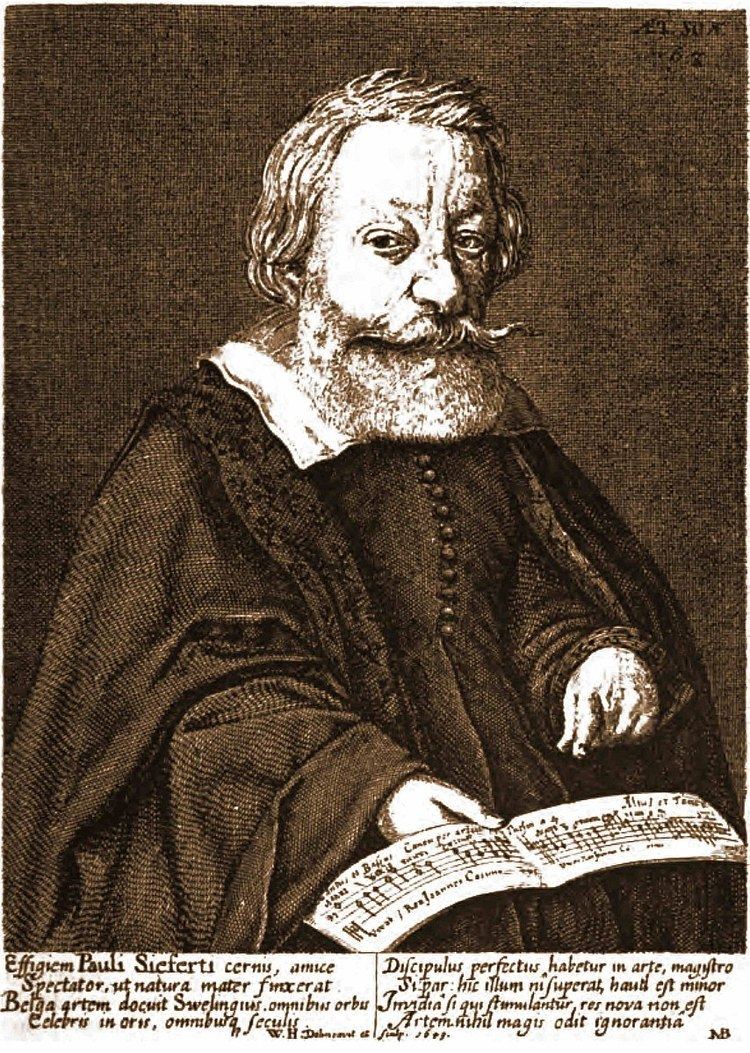Name Paul Siefert | Role Composer | |
 | ||
Died May 6, 1666, Gdansk, Poland Similar People Heinrich Scheidemann, Johann Adam Reincken, Jan Pieterszoon Sweelinck, Samuel Scheidt, Franz Tunder | ||
Danziger tabulatur 1591 phantasia sexti toni paul siefert 1586 1666 paduana
Paul Siefert (variants: Syfert, Sivert, Sibert) (23 May 1586 – 6 May 1666) was a German composer and organist associated with the North German school.
Contents
- Danziger tabulatur 1591 phantasia sexti toni paul siefert 1586 1666 paduana
- Paul Siefert 1586 1666 Fantasia Prima Fantasia a 3
- Biography
- Music
- Vocal
- Instrumental
- Theoretical
- References
Paul Siefert (1586-1666) - Fantasia Prima (Fantasia a 3)
Biography
He was born in Danzig (Gdańsk in Poland) to his father's second wife and named after his father (died 1604), who was a procurator. The Danzig city council gave scholarships to Samuel Scheidt and him to study with Jan Pieterszoon Sweelinck in Amsterdam from 1607 to 1610; in the autumn of that year, he returned home where he became assistant organist of the Marienkirche. His application to become principal organist of the church after Cajus Schmiedtlein died in March 1611 failed due to complaints about his arrogance and style of performance.
He moved to Königsberg in 1611 to take up the post of organist of Altstadt Church, and became court organist at Warsaw in 1616. He returned to Danzig in 1623 to become principal organist, where he remained until his death; he failed in an application for the post of Kapellmeister in 1627 after the death of Andreas Hakenberger, who was succeeded by Kaspar Förster. He did not lead a serene life; he became sidelined at the Warsaw court, and had long-running feuds with Kaspar Förster, choirmaster of the Marienkirche from 1627 to 1652, and Marco Scacchi, Polish court choirmaster from 1628 to 1649.
Music
His first book of Psalmen Davids consists of two concertos for three and four voices and twelve settings for four and five voices of material drawn from the Calvinist Goudimel-Lobwasser psalter of the Reformed Church. The form used is that of the chorale motet, the instrumental parts having little significance, mainly doubling the voices. Psalmorum Davidicorum II consists of fifteen psalms for four to eight voices, a concerto for four voices, and an eight-part instrumental canzona; the works are antecedents of the concertato chorale motet and the chorale cantata; there are instrumental preludes and ritornellos, and alternating sections of solo and tutti passages.
His keyboard works bear some similarity to Sweelinck, but are not generally of a high quality. The highly ornamented line is usually played by the right hand with the chorale underneath. This texture is interrupted by episodes exploiting effects of harmony and colour.
